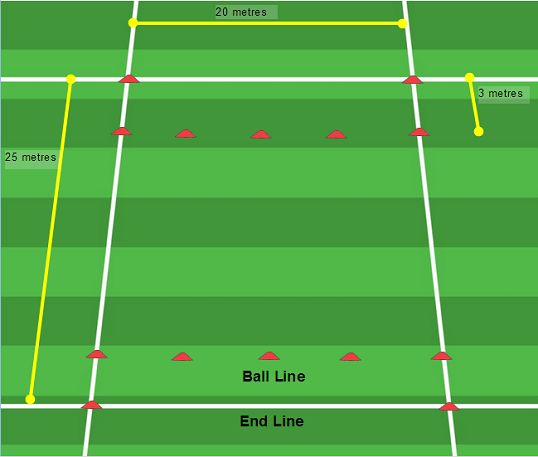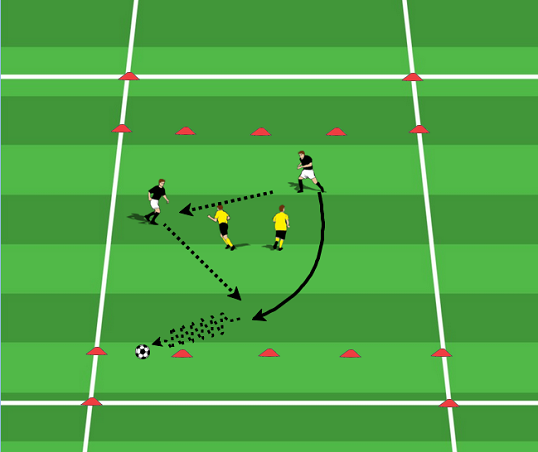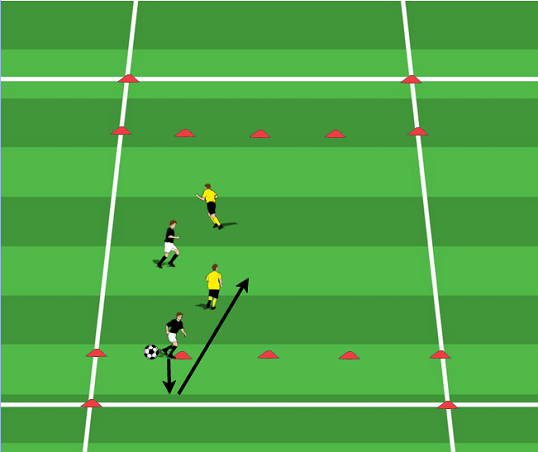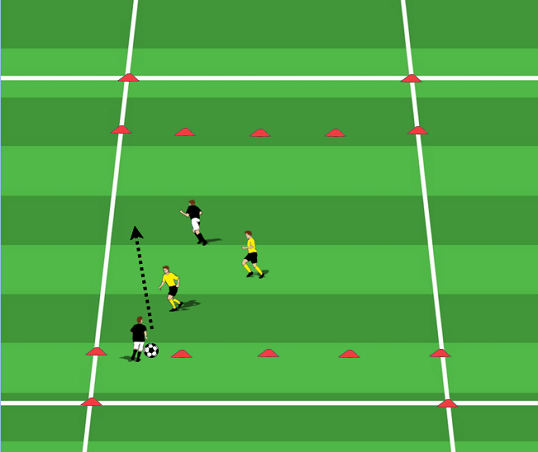By Keith Scarlett
This activity works on 1v1 defending, pressure, cover, recovery and defensive communication.
When moving up the pitch to attack the opposition’s goal, losing possessing can lead to a counter-attack. This technical training activity is designed to help players understand the importance of falling back to defend their own goal. A couple of players will need to pass around or dribble past opposition to score a point and when they do, or if things don’t work out; they need to get back quickly and help out on defense. REMEMBER: the BALL is the MOST IMPORTANT THING!
Set-up:
The playing area is 25 x 20 metres. Only one ball will be in play at a time. There are two-lines on either end of the pitch, the end-line; which is at either end of the playing area and the ball-line; which is 3-metres inside the playing area; per the diagram.
To start this activity, one team starts with possession of the ball, at random. This team’s (the attacking team), players need to pass or dribble past their opponents to reach the “ball-line.” The ball MUST be stopped ‘DEAD’ on the “ball-line” for the attacking side to win a point.
Once the ball has been brought to a complete halt, the attacking player who stopped the ball now becomes the defensive player who has to keep running on towards the edge of the playing area, touch the end-line and come back in to defend with their teammate.
The other team, who was previously defending, now takes possession of the ball as soon as it is stopped on the “ball-line” and must restart as quickly as possible to take advantage of the superior numbers.
[wpsharely id="2988"][/wpsharely]This can become an extremely high-intensity game, so be sure to rotate teams on and off every 90 seconds-2 minutes allowing them recovery time.
Progression/Variations:
- Increase or decrease the gap between the ball-line and the end-line without increasing the playing area length.
- Add another player to each team and make it 3v3 with the same rules, only a bigger playing area.
- If possession is lost in any part of the pitch, then the player who is tackled or whose pass is intercepted, has to go all the way to the opposition’s end-line, touch it and return to defend.
- Coaching Points:
- Encourage good verbal and non-verbal communication between the defenders.
- Defending players need to chase, even if they are beaten. This allows them to restart, if the opposition scores a point, as quickly as possible and take advantage of the opposition being out of position.
- When waiting for reinforcements, the solitary defending player needs to “get stuck-in,” getting to the ball FAST, TIGHT and HARD, forcing the attacker to drop their head, getting their shoulder on the ball and driving the attacker to the spot.
- Defenders must make sure they are not cut-out of the game with a pass, which means they need to lock-up immediately and gets their HANDS ON!
- Returning defensive reinforcements need to recover into positions where they can mark, “BALL SIDE WIDE and GOAL SIDE MIDDLE, always pushing mark away from goal.
- Defenders should be using their body to get between the opponent and the ball; using their arms and hip rotation to get proper positioning: ELBOW-DEEP!
- Quality of passing and movement to ensure quick counter-attacks.
- Players need to make space to receive the ball.






